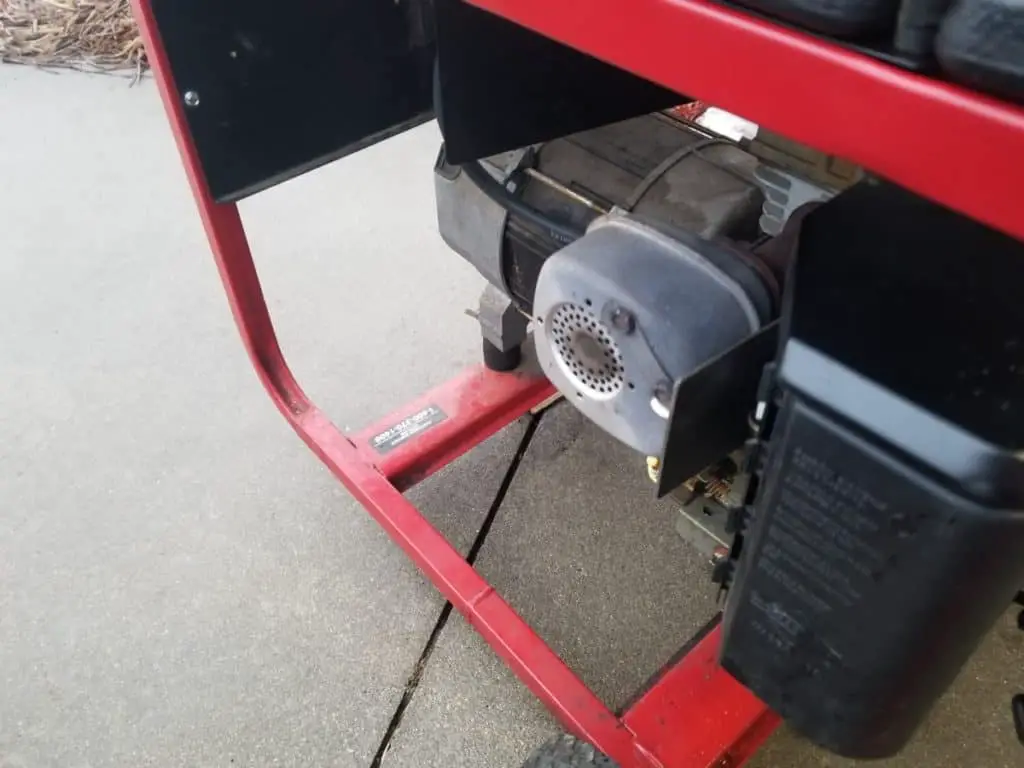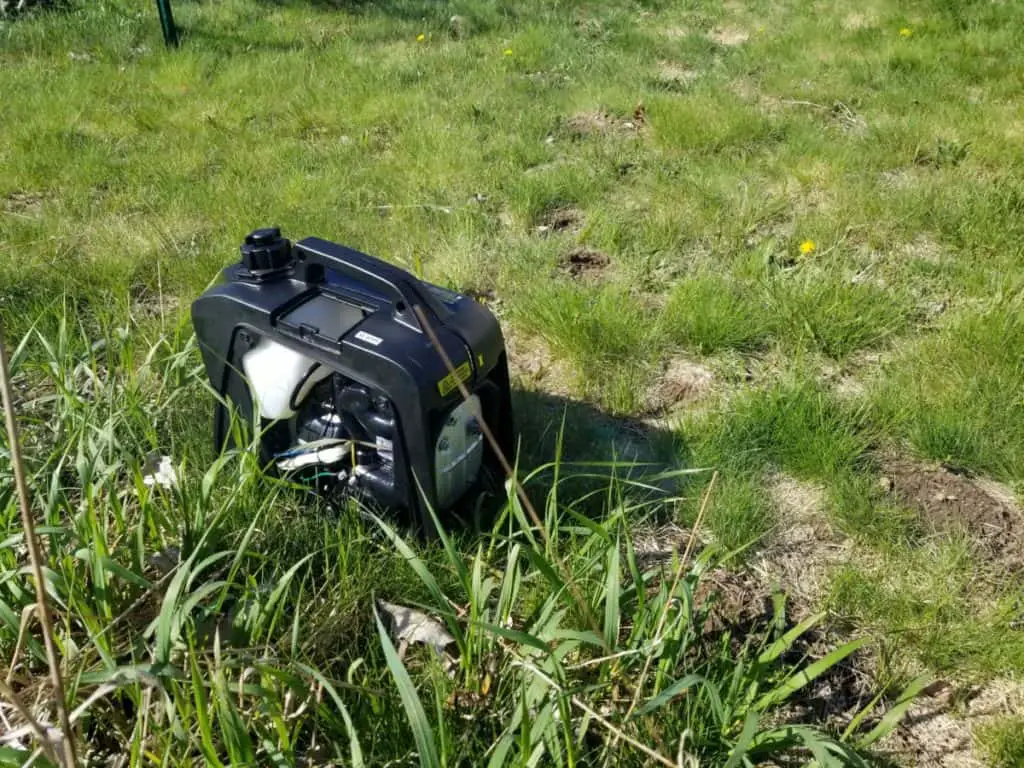Whether you’re camping, in a residential neighborhood, or even out in the country — a loud generator can increase tensions between otherwise peaceful friends and neighbors.
What if I told you there are some very cheap and simple ways to make your generator quieter?
Let’s be honest though, we’re never going to eliminate the noise of a generator, but even some simple steps can make a 10 decibel difference which can be perceived as being half as loud.
A portable generator can be made quieter by placing the generator on grass instead of concrete or by placing a rubber mat underneath it in order to reduce mechanical vibrations. Generator exhaust noise can be reduced by deflecting the noise to the earth with a lean-to structure. Switching to an inverter generator, if possible, will reduce noise considerably.
Below is a table with steps you can take, in recommended order, to save the sanity of yourself and those around you. Afterward, I’ll go into deeper explanations to hopefully help you out and offer a few recommendations of you just can’t make things work with what you currently have.
How to Make a Generator Quieter
| What to do: | Why: | How to do it: |
|---|---|---|
| Check Exhaust Assembly | Cracks, holes, or a blown gasket will lead to uncontrollable noise | Repair or replace as necessary |
| Redirect Exhaust | Sound waves directly aimed by exhaust will be loudest | Point the exhaust away from yourself and others if possble |
| Relocate Generator | The closer, the louder | Move generator further away if you can, but make sure you have a thick, quality cord to compensate for voltage drop |
| Check Surface Below Generator | Hard surfaces such as concrete and wood will bounce sound waves back to you and increase mechanical vibrations | Move to grass or sand, place a rubber mat underneath to help with vibrations |
| Deflect Noise | Exhaust noise is aimed but mechanical noise/vibrations are omni-directional | Use scrap plywood. structurewood, drywall, or foam insulation panels to direct noise towards the soft ground for absorption (think A-frame structure); Use caution to not restrict air-flow! |
| Contain the Noise | If properly constructed, you can muffle the mechanical noise and vibrations | Build or buy (Zombie Box, for example) your own "quiet box". Proper exhaust and air-flow must be maintained so use caution! |
| Switch Generator Types | By design, conventional generators are far louder than an inverter generator | If it meets your needs, purchasing a properly-sized inverter generator will reduce noise by 10-20+dB on average; Inverter generators are typically 1000-3000 kW |
| Upgrade to Higher Quality | Better brands are better engineered with quality materials and more efficient tolerances to reduce exhaust and mechanical noise | Honda and Yamaha are top of the line, but even upgrading from a "no-name" brand to a middle-of-the-road brand can make a considerable difference |
Steps to Make Your Generator Quieter
Step 1: Inspect the Exhaust Assembly
First, you’ll want to make sure there are no cracks, holes, and that the gasket between the exhaust and the combustion chamber isn’t blown. If you see any of these things, you’ll definitely have the raw sound of the combustion of the engine to deal with. Replace or repair as necessary.

Step 2: Redirect Exhaust
If your exhaust is pointed toward you or others it will obviously be louder than if it were pointed away. Save your relationships and point it in the best direction possible.
Step 3: Relocate Generator
Moving your generator further away will naturally dissipate the sound waves. If you’re able to, even an extra 20′ can make big difference depending on the situation.
Just be aware that you’ll experience voltage drop the further you move your generator from what you’re trying to power. So, if you were using a cheap 25′ 120v cord from the local big box store to power your appliance and you move your generator to 75′, you might not get away with simply plugging in another cheap 50′ cord.
It all depends on what you’re trying to power and the distance (cord length) you are from that item(s). Do yourself a favor and buy a heavy-duty, thick copper cord to run from your generator to that which you’re trying to power. It costs money upfront, but it’s worth it to not stress your generator or burn out the motors and compressors on your appliances.
Never relocate your generator indoors (house, garage, shed)! You can check out my article here on how deadly generators can be when operated indoors and why you shouldn’t do it.
Step 4: Check Surface Below Generator
If you scream with your mouth against a hard wall or scream with your mouth against a pillow, you know which one will be quieter due to the absorption and deflection of sound waves. Likewise, you know that if you have a hard mattress or a mattress with a memory foam topper that you will experience far less vibrations with the latter.

The same concept applies to your generator. If you have it on concrete or wood, it’s going to be loud. Do yourself a favor and move it to grass or sand. If you can’t, you can always use a rubber mat underneath to help with the mechanical noise/vibrations which are the major source of your noise.
You know that yoga mat you haven’t used in years? Fold that thing in half, place underneath, and take note of the difference.
Step 5: Deflect Noise
Think of playing ping pong with the sound waves coming from your genset. If you place a board upright next to the generator, you’re simply going to bounce the sound waves in the opposite direction. If you angle the board downward like a lean-to structure next to the generator, then the noise will be deflected downward to the earth.
Hopefully, at this point, you have the generator on a soft surface that will absorb the noise instead of deflect it (grass vs. concrete). With a few screws, nails, or even some duct tape, it shouldn’t take much talent to throw together some scrap boards, drywall, or foam insulation panels in a simple lean-to design or a-frame.
Whenever you start obstructing the area directly around your generator you need to exercise great caution to not restrict the air-flow to the generator or the exhaust trying to leave. Generators are air-cooled and if they overheat they will experience intake issues and then engine failure.
Step 6: Contain the Noise
This goes in line with the step above but it’s a more “dedicated” solution. You can see pictures of all different “quiet boxes” online.
If you were cautious with the step above regarding air-flow, you want to be paranoid about this step so that you don’t suffer catastrophic engine failure from a seized engine due to overheating.
Zombie Box has a lightweight solution that is worth checking out if you have an interest. It would be perfect for camping since it breaks down so easily as well!
Step 7: Switch Generator Types
If you’re not powering too much (1,000-3,000 kW) you might be able to get away with an inverter generator.
Conventional generators, by design, are always going to be louder than their inverter generator counterparts. The difference between the noise levels are night and day!

My inverter generator purrs and you can barely hear it after you move away more than 40 feet. My conventional generators are like lawnmowers — you’re going to hear them regardless unless you take some of the steps above.
Step 8: Upgrade to a Higher Quality Genset
You can always upgrade to a higher quality generator (and take some of the steps above) to further reduce the noise levels you’re experiencing.
I know it’s expensive, but the better the quality (Honda and Yamaha are the best, in my opinion), the better your experience will be. However, if you have a cheap no-name brand generator and you upgrade to a mid-level brand, you’ll also likely see a world of difference.
The more reputable generators use better materials and have better tolerances which reduce vibrations and mechanical noise as your engine cycles at 3,600 rotations per minute! Plus, they hold their value for a lot longer. A used Honda is almost always more expensive than a mid-grade (but quality) generator of the same size that’s new.
Buy a quality brand generator from the get. The cheaper ones are the loudest. Most of the noise isn’t from the exhaust. It’s from the harmonic distortions created by the vibrations and the housing itself. The better the brand, the better the materials and workmanship. The better the result. The reviews speak for themselves. Plus, the better brands hold their value a lot longer.
How Loud is a Generator on Average?
The table below sums it up the best.
Keep in mind that exhaust noise is only a fraction of the equation. Much of the noise that you hear is vibrations and noise from rotating metal. These create basic frequencies that are capable of penetrating most things.
That being said, the higher quality (better brand) generator you purchase, the quieter it will be when compared to other generators of the same size. They are simply machined and engineered in a way to be smoother in their operation with better tolerances and this will reduce not only mechanical clatter but exhaust as well.
Also, these advertised noise levels are not when the generator is at a full load, so you’ll definitely see an increase in perceived noise as you reach the capacity of any given generator.
How Loud are Portable Generators in Decibels (dB)
| Portable Generator Type | Generator Size in Kilowatts (kW) | Decibels (dB) |
|---|---|---|
| Conventional | 2,000-4,500 | 65-69 |
| Conventional | 5,000-7,500 | 67-74 |
| Conventional | 7,500-12,000 | 74-90 |
| Inverter | All | 48-61 |
Understanding Decibels to Reduce Your Generator’s Noise:
When it comes to decibels (dB) I’m not a scientist and I’m not going to pretend to play one on TV or in a blog, but basically the range over which a healthy human ear can detect noise is so broad, that a linear scale does not make sense. Also, just because we can hear two different noises doesn’t mean that we can necessarily perceive which one is actually louder since the scale is so broad.
Due to that, the world condensed a linear scale into a logarithmic scale to make things easier (though more confusing to the average person) to deal with.
Essentially, if you have a generator that is 60dB and a generator that is 63dB, you’re not going to be able to tell the difference. One has greater sound pressure, but you can’t perceive it when compared to another one that close on the scale.
Now, if you have a generator that is 60dB and another that is 70dB, then the one that is 70db will be perceived as being 2x as loud to your ear since around 10dB increase is a doubling in perception of loudness.
Now that we know that, we don’t really need to reduce our 70dB generator down to zero, we would probably be happy by simply reducing it by 10dB so that the the 60dB level will be half of what it was.
For context, a 60dB noise level is perceived as a conversation around a dinner table. A 70dB noise level is perceived as a hair dryer or city traffic. That could be enough to soothe tensions between you an a neighbor!

